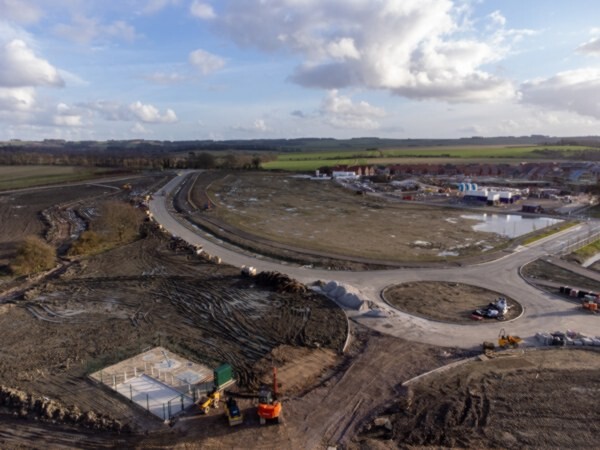 The journey towards the all electric site
The journey towards the all electric site
To say that ecological concerns are high up on the agenda of most plant, access and construction companies nowadays is not news. Plant hire companies in the UK are currently upgrading their inventory from diesel-powered machines to electric and hybrid machines in order to comply with environmental legislation and consumer expectations. The UK has committed to becoming Net Zero by 2030, and the construction industry has an important role to play in achieving this goal. The use of electric plant and machines in construction has been identified as a key factor in reducing the industry's carbon footprint, while also providing other benefits such as reduced noise pollution and lower maintenance costs.
As additional pressure is piled on with the emergence of Low Emission Zones and Clean Air zones in major cities, hire companies are keen to find definitive solutions that are fit for purpose and compliant with legislation.
The benefits of electric plant and machinery
Construction sites require a lot of power, from lighting and heating to heavy machinery and power tools. Traditionally, this power has been supplied by traditional fuel sources, with diesel powered machines and diesel generators, which are noisy, polluting and expensive to run. Because diesel machines emit harmful gases such as carbon monoxide, nitrogen oxides and particulate matter, these machines are subject to increasing limitations in their use. Diesel machines cannot be used for work indoors or in confined spaces, and residential areas often have particle emission and noise emission limitations which exclude the use of diesel powered machines.
Electric machines offer series of benefits over their diesel-powered counterparts:
- They produce zero emissions, making them environmentally friendly and apt for indoor use.
- They are significantly quieter than diesel-powered machines, which is a major advantage- for construction sites located in urban areas or close to residential areas.
- Electric machines also have fewer moving parts and rely less on hydraulics, which means that they are generally cheaper to maintain.
The end of rebated diesel for the construction sector was set to usher in a smooth transition to electric construction sites and plant, however the recent general energy crisis experienced throughout Europe has highlighted some of the obstacles in the path of the fully-electric site.
Transitioning to all-electric plant
All-electric sites are becoming more popular as electric machines provide the versatility of being used in any setting: from rugged remote sites, to inside public buildings. However, electric machines also come with certain drawbacks:
- They tend to be more expensive to purchase than diesel-powered machines, which can be a barrier for smaller plant hire firms or those working on tighter budgets. The return on investment for these machines is also lower, as the higher price does not correspond with a longer machine life.This higher cost must either be absorbed by the hirer, or passed on to the customer.
- The batteries that power electric machines can be costly to replace, which may make them less cost-effective in the long run.
- Rapidly evolving technology means that machines and their batteries are likely to quickly become obsolete as improved power solutions and features are developed.
- There are important challenges when it comes to charging these machines, particularly on remote sites or when a large project requires a significant number of electric machines.
- The current grid capacity is insufficient to meet the power requirements of these machines, which means that charging can be slow and potentially disruptive to the project schedule.
- On fully remote sites charging is even more complicated as remorse sites are typically dependent on diesel.
Charging electric machines: a bone of contention
Electricity produced from renewable sources is cheaper and cleaner than diesel, true; but currently the grid is still heavily reliant on non-renewable energy sources, and electricity is not cheap. The issue of charging is an expensive one, and a debate is being generated around who absorbs this cost. It is currently unclear whether the plant hire company or the end client should be responsible for the cost of charging electric machines. This is an issue that will need to be resolved in order for the industry to fully embrace electric machines and for them to become a viable alternative to diesel-powered machines. High energy costs and higher machine prices combined with general inflation are making green sites more of a status symbol than an accessible solution.
 Despite these challenges, plant hire companies are working hard to resolve the issues associated with electric machines. There are several solutions that are currently available or under development, including:
Despite these challenges, plant hire companies are working hard to resolve the issues associated with electric machines. There are several solutions that are currently available or under development, including:
- The use of HVO-powered generators (although this is an expensive option)
- Generators powered by renewable energy sources such as solar power or hydrogen
- Site batteries and temporary power supplies for construction sites that can be used to store energy and provide a reliable source of power for electric machines.
- The use of hybrid machines and generators that can switch between diesel and electric power.
- Improvements to battery technology are also being made, with researchers exploring alternative materials to lithium and developing AGM batteries that offer a longer lifespan than traditional lithium-ion batteries.
- Upgrading the grid
With companies and end consumers rushing to meet Net Zero targets, it is becoming increasingly evident that the U.K.’s electrical infrastructure will have to undergo a rapid and fundamental transformation to support a large-scale migration from fossil fuels to full reliance on the grid. It will also be key for the grid itself to become less reliant on fossil fuels and to obtain electricity from clean, renewable energy sources for the environmental impact of these measures to be felt. This will require significant investment in the grid infrastructure and the development of new technologies to enable the efficient storage and distribution of renewable energy.
Navigating the transition between diesel and electric sites
Despite the teething problems associated with the rollout of electric machines, it is clear that they represent a step in the right direction for long-term sustainability. Only by embracing these new technologies and making the necessary investments in infrastructure and research can the construction industry hope to meet its Net Zero 2030 targets. The challenges associated with electric machines will undoubtedly lead to the development of more efficient and cost-effective solutions, which will benefit both the industry and the environment in the long run.
At Mr plant Hire we work alongside other industry-leading companies to provide energy efficient and environmentally-friendly site solutions. Our new fleet of electric machines includes the Dingli JCPT 1418 DC Electric Scissor Lift and the Niftylift HR12 NE narrow electric boom lift.
We are also heavily invested in hybrid machine technology, due to the versatility that these machines offer. Our new rough-terrain hybrid boom lift range includes the Dingli BA16HRT and BA20HRT models.
If you would like to learn more about our environmentally-friendly site solutions, get in touch with MPH on 0208 351 3434. Our friendly team will be happy to discuss the best solutions for your project.
https://www.ivtinternational.com/opinion/the-problems-of-industrial-vehicle-electrification.html
